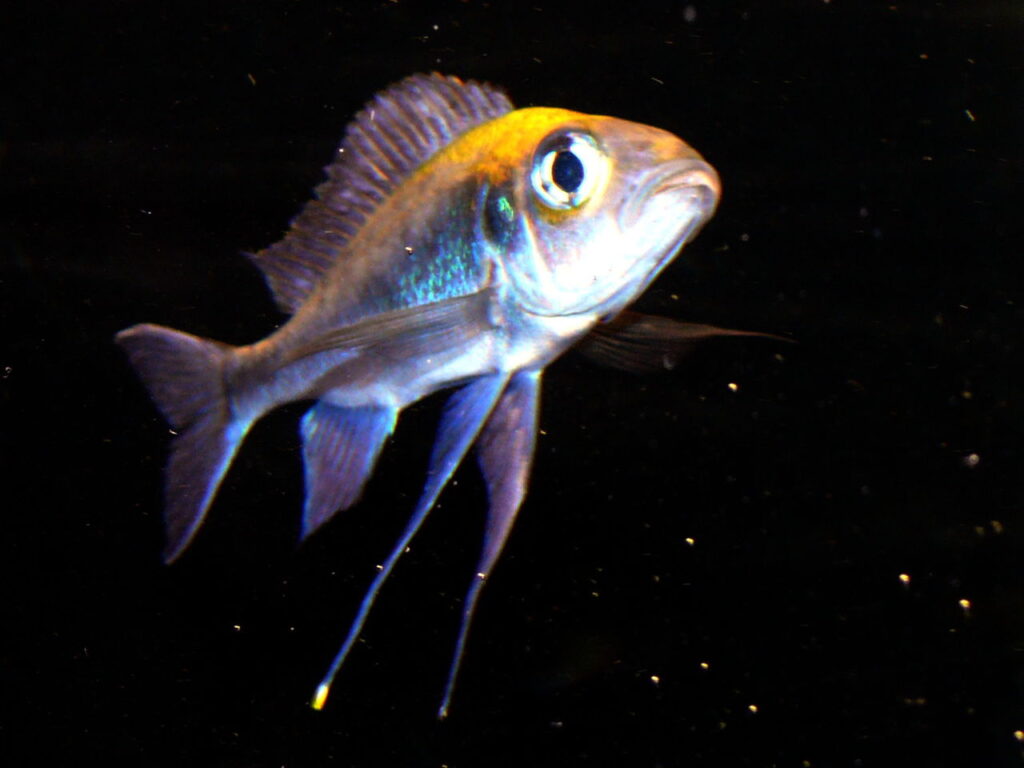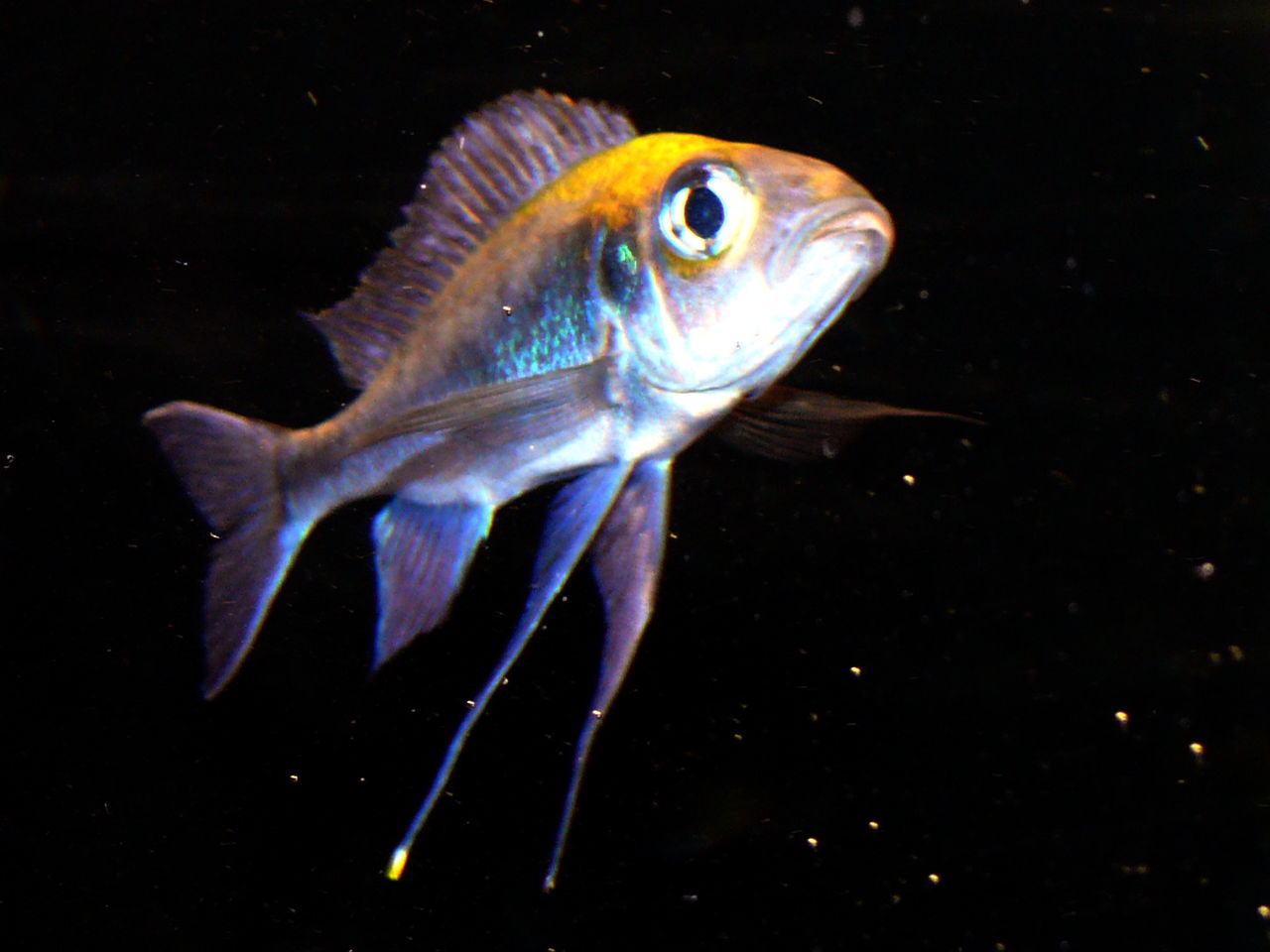Have you ever seen a fish that looks like it’s wearing feathers? Meet the Malawi Featherfin, a fish that’s as fancy as its name sounds! This pretty swimmer, also called Cyathopharynx furcifer by scientists, isn’t from Malawi at all. It actually lives in Lake Tanganyika, a big lake in Africa. These fish are part of a big family called cichlids, which are known for being colorful and smart.
Table of Contents
Imagine a fish with elongated pelvic fins that resemble delicate feathers, gently swaying in the water. That’s the Malawi Featherfin for you! These elegant creatures are known for their striking appearance and interesting behaviors. Males are particularly eye-catching, sporting vibrant colors and those signature long fins that give them their common name.
One of the most intriguing aspects of this species is its unique breeding behavior. Males build elaborate sand castles or bowers to attract females. It’s like underwater architecture! They meticulously construct these structures, which serve as both a display of their fitness and a spawning site.
The scientific name Cyathopharynx furcifer has a fascinating meaning. “Cyatho” refers to a cup-like shape, “pharynx” means throat, and “furcifer” translates to “fork-bearer.” This name likely describes the fish’s physical characteristics, particularly its throat region and forked tail.
In the aquarium trade, you might come across this fish under various names, including the Featherfin Cichlid or Tanganyika Featherfin. No matter what you call it, its charm remains the same.
These cichlids are primarily plankton eaters, gracefully gliding through the water to snatch tiny organisms. They prefer the middle to lower regions of the aquarium, often found near rocky areas that mimic their natural habitat in Lake Tanganyika.
Interestingly, recent research has suggested that what we know as Cyathopharynx furcifer might actually be two distinct species living side by side in the lake. Scientists observed two color morphs of males – one with a bluish body and yellow anal fin, and another with a blackish body and black anal fin. Genetic and morphological studies support the idea that these could be separate species. This discovery adds another layer of intrigue to these already fascinating fish!
The Malawi Featherfin’s journey from Lake Tanganyika to our aquariums is a testament to the enduring appeal of cichlids. Since the 1970s, when they were first exported from the lake, they’ve faced challenges in transportation but have persevered thanks to dedicated breeders.
It’s a living reminder of the wonders that lie beneath the surface of our planet’s ancient lakes.

Malawi Featherfin Key Information
The Malawi Featherfin, despite its name, is a stunning cichlid native to Lake Tanganyika. These fish are a sight to behold, with males displaying vibrant hues of blue, green, and yellow. Their most striking feature is the elongated, feather-like pelvic fins that give them their common name. Females are typically less colorful but still elegant, often sporting a silvery-gray body with subtle yellow accents. The fish’s coloration can vary depending on mood, breeding status, and environmental factors, making them a dynamic and visually captivating addition to any aquarium.
Here’s a detailed table about the Malawi Featherfin (Cyathopharynx furcifer):
| Family | Cichlidae |
| Origin | Lake Tanganyika, Africa |
| Price | $15 – $30 |
| Common Names | Featherfin Cichlid, Tanganyika Featherfin |
| Variants | Various color morphs |
| Ideal Tank Size | 50 gallons |
| Water Parameters | pH 7.8-9.0, 24-28°C |
| Lifespan | 10-15 years |
| Full Size | 5-6 inches |
| Natural Environment | Rocky substrates in freshwater lakes |
| Behavior | Bottom, middle, and top dweller; active swimmer |
| Habitat Preference | Prefers rocky and open areas |
| Aquarium Decoration | Rocks, caves, and open swimming space |
| Ideal Tank Mates | Other Tanganyikan cichlids, Plecos |
| Fish to Avoid | Aggressive cichlids, small fish species |
| Best Foods/Diet | Omnivorous; pellets, flakes, and vegetable matter |
| Disease | Susceptible to ich, fin rot |
| Sex-Switch | No known instances |
| Gender Differences | Males have longer fins and brighter colors |
| Care Level | Moderate |
| Breeding Level | Difficult |
Ideal Tank Mates for Malawi Featherfin
The Malawi Featherfin, despite its name, is native to Lake Tanganyika. When selecting tank mates, it’s crucial to choose species that share similar water parameters and temperaments. Here are 10 ideal tank mates for the Malawi Featherfin, each offering unique compatibility benefits:
Yellow-Tailed Acei (Pseudotropheus acei)
The Yellow-Tailed Acei is an excellent choice for cohabitation with the Malawi Featherfin. Its peaceful nature and preference for the middle to upper water levels complement the Featherfin’s habits. The Acei’s vibrant colors also provide a beautiful contrast to the Featherfin’s elegant appearance.
| Common/Market Names | Price Range | Care Level | Behavior | Life Span | Max Size |
|---|---|---|---|---|---|
| Yellow-Tailed Acei, Yellow-Tail Acei | $15-$30 | Easy | Peaceful | 8-10 years | 5 inches |
Tanganyikan Lamprologus (Lamprologus ocellatus)
This small, shell-dwelling cichlid is a great tank mate for the Malawi Featherfin. Its bottom-dwelling nature means it won’t compete for territory with the Featherfin, which prefers the mid to upper water levels. The Lamprologus adds interesting behavior to the tank with its shell-dwelling habits.
| Common/Market Names | Price Range | Care Level | Behavior | Life Span | Max Size |
|---|---|---|---|---|---|
| Gold Ocellatus, Dwarf Ocellatus | $20-$40 | Moderate | Semi-aggressive | 5-8 years | 2.5 inches |
Jullidochromis transcriptus
The Jullidochromis transcriptus is a peaceful, rock-dwelling cichlid that makes an excellent tank mate for the Malawi Featherfin. Its preference for lower regions of the tank means it won’t interfere with the Featherfin’s territory, while its striking black and white stripes add visual interest to the aquarium.
| Common/Market Names | Price Range | Care Level | Behavior | Life Span | Max Size |
|---|---|---|---|---|---|
| Masked Julie, Masked Jullidochromis | $15-$30 | Moderate | Peaceful | 5-8 years | 3 inches |
Altolamprologus calvus
The Altolamprologus calvus is a unique-looking cichlid that pairs well with the Malawi Featherfin. Its slow-moving nature and preference for rocky areas make it a non-threatening presence in the tank. The calvus’s distinctive compressed body shape adds diversity to the tank’s appearance.
| Common/Market Names | Price Range | Care Level | Behavior | Life Span | Max Size |
|---|---|---|---|---|---|
| Black Calvus, White Calvus | $30-$60 | Moderate | Peaceful | 10-15 years | 5.5 inches |
Synodontis petricola
This catfish species is an excellent bottom-dweller to pair with the Malawi Featherfin. The Synodontis petricola helps maintain tank cleanliness by scavenging for leftover food, and its nocturnal activity pattern means it won’t compete with the Featherfin for resources during the day.
| Common/Market Names | Price Range | Care Level | Behavior | Life Span | Max Size |
|---|---|---|---|---|---|
| Dwarf Petricola, Pygmy Cory | $15-$30 | Easy | Peaceful | 5-8 years | 4 inches |
Cyprichromis leptosoma
The Cyprichromis leptosoma is a schooling cichlid that occupies the upper water levels, making it an ideal tank mate for the Malawi Featherfin. Its graceful swimming patterns and shimmering colors add movement and beauty to the aquarium without threatening the Featherfin’s territory.
| Common/Market Names | Price Range | Care Level | Behavior | Life Span | Max Size |
|---|---|---|---|---|---|
| Sardine Cichlid, Blue Flash | $20-$40 | Moderate | Peaceful | 5-8 years | 5 inches |
Neolamprologus brichardi
The Neolamprologus brichardi is a elegant cichlid that can coexist peacefully with the Malawi Featherfin. Its preference for rocky areas and cave-like structures means it won’t compete for open swimming spaces. The brichardi’s unique fin extensions add a touch of elegance to the aquarium.
| Common/Market Names | Price Range | Care Level | Behavior | Life Span | Max Size |
|---|---|---|---|---|---|
| Princess Cichlid, Fairy Cichlid | $15-$30 | Easy | Semi-aggressive | 8-10 years | 4 inches |
Eretmodus cyanostictus
This algae-eating cichlid is a great addition to a tank with Malawi Featherfins. The Eretmodus cyanostictus helps keep the tank clean by grazing on algae, and its small size and bottom-dwelling nature mean it won’t compete with the Featherfin for territory.
| Common/Market Names | Price Range | Care Level | Behavior | Life Span | Max Size |
|---|---|---|---|---|---|
| Goby Cichlid, Tanganyika Clown | $20-$40 | Moderate | Peaceful | 5-8 years | 3.5 inches |
Xenotilapia flavipinnis
The Xenotilapia flavipinnis is a sand-sifting cichlid that complements the Malawi Featherfin well. Its behavior of constantly sifting through the substrate helps keep the tank clean, while its peaceful nature ensures it won’t bother the Featherfin.
| Common/Market Names | Price Range | Care Level | Behavior | Life Span | Max Size |
|---|---|---|---|---|---|
| Yellow Fin Xenotilapia, Sand Sifter | $30-$50 | Moderate | Peaceful | 5-8 years | 4 inches |
Tropheus moorii
While more challenging to keep, the Tropheus moorii can be a compatible tank mate for the Malawi Featherfin in larger aquariums. Its active nature and bright colors add energy and visual interest to the tank. However, careful attention must be paid to their diet and water quality.
| Common/Market Names | Price Range | Care Level | Behavior | Life Span | Max Size |
|---|---|---|---|---|---|
| Blunthead Cichlid, Moorii | $30-$60 | Difficult | Semi-aggressive | 10-15 years | 6 inches |
FAQs about Malawi Featherfin
How often should I feed my Malawi Featherfin?
Feed your Malawi Featherfin 2-3 times a day, offering only as much food as they can consume within 2-3 minutes. This helps maintain good water quality and prevents overfeeding.
Can Malawi Featherfins change color?
Yes, Malawi Featherfins can change color based on their mood, stress levels, and breeding status. Males, in particular, may become more vibrant during courtship displays.
Do Malawi Featherfins need a special diet?
While they are omnivorous, Malawi Featherfins benefit from a diet high in vegetable matter. Offer them a variety of foods including spirulina flakes, algae wafers, and occasional frozen or live foods like brine shrimp.
How can I tell if my Malawi Featherfin is stressed?
Signs of stress in Malawi Featherfins include loss of appetite, hiding more than usual, rapid breathing, and faded coloration. If you notice these signs, check your water parameters and tank conditions.
Are Malawi Featherfins good community fish?
Malawi Featherfins can be good community fish when kept with suitable tank mates. They’re generally peaceful but may become territorial during breeding. Avoid keeping them with very aggressive or much smaller fish.
How often should I perform water changes for my Malawi Featherfin tank?
Perform weekly water changes of about 20-30% to maintain good water quality. Malawi Featherfins prefer stable water conditions, so consistent maintenance is key.
Can Malawi Featherfins live in a planted tank?
While Malawi Featherfins come from a rocky habitat, they can adapt to planted tanks. Choose hardy plants that can tolerate higher pH levels, and be prepared for some plant nibbling.
How long does it take for Malawi Featherfins to reach full size?
Malawi Featherfins typically reach their full size of 5-6 inches in about 2-3 years, given proper care and nutrition.
Do Malawi Featherfins need special lighting?
Malawi Featherfins don’t have specific lighting requirements, but a good quality LED light that mimics natural daylight can help showcase their colors and promote a natural day-night cycle.
How can I encourage breeding behavior in my Malawi Featherfins?
To encourage breeding, provide plenty of open sandy areas for males to build their bowers. Maintain excellent water quality, offer a varied diet, and gradually increase the water temperature slightly. Be patient, as breeding can be challenging in captivity.

Leave a Reply